Ortiz de Montellano Paul R.(Ed.) Cytochrome P450. Structure, Mechanism, and Biochemistry
Подождите немного. Документ загружается.


Cytochrome P450s in Plants
565
!ll
c .
~
o 42
"^ •"«
m CD
^e
s ^
S .-i
, . L-
LU .-ti
T— C
^ 2
^
fc
o^
•D
CO
o
03
O
1-
t^
-o
(D
_^
B^
'5
C/5
S5
o
o
o
^
I

566
Kirsten A. Nielsen and Birger L. Moller
R,,^^COOH
NH,
AUK'M + U, NAUKM
H
ac/-nitro
compound
< >
nitrile oxide
cysteine
" ^ Kl
S-alkyl-
thiohydroximate
UDPG PAPS
^ M ^ N
N^
thioliydroximic
acid
desulfo-
glucosinolate
glucosinolate
Figure 12.8. The biosynthetic pathway for glucosinolate production. Reprinted with permission from Wittstock
and Halkier (2002)9.
glucosinolate formation. Most likely, this involves
formation of a metabolon as demonstrated in
sorghum (Section 5.1.2). An Arabidopsis double
mutant knocked out in both CY79B2 and
CYP79B3 completely lack indole-derived glu-
cosinolates, but show subtle morphological
mutant phenotype. The subsequent conversion of
oximes to glucosinolates is catalyzed by members
of
the
CYP83 family (Section 7; Figure 12.8).
5.3. Functional Diversity
among CYP71s
In contrast to the CYP79 family, the CYP71
family is functionally diverse and constitutes the
largest A-type plant P450 family with a total of
110 members divided into 18 subfamilies.
5.3.1.
CYP71AandCYP71B
Subfamilies
The CYP71A subfamily contains 28 members
including 17 annotations from the A. thaliana
genome. The first member of this subfamily was
derived from avocado^ ^ No specific enzymatic
activity has been demonstrated for the members of
the CYP71A subfamily. CYP71A10 from Glycine
max (soybean) catalyzes conversion of the phenyl-
urea herbicides, fluometuron, linuron, chlor-
toluron, and diuron into more polar compounds^^.
This is unlikely to be the in planta biological
function of the enzyme and surely does not
explain the apparent evolutionary need for main-
tenance of 17 isoforms in the A. thaliana
genome^ ^. The CYP71B family is very large and
composed of 36 members all annotated from the
A.
thaliana genome. The subfamily was first
established based on a sequence with unknown
biological function from Thlaspi arvense (field
penny-cress), which like A. thaliana belongs to
the
Brassicacea^'^.
5.3.2. CYP71C Subfamily: Grass-
Specific Defense Compounds
The CYP71C subfamily is comprised of a total
of
23
members with 11 from Zea mays (com), 11
from Trititum aestivum (wheat), and a single
member from H. vulgare (barley), all belonging to
Poacea. The CYP71C subfamily possesses some
very special enzymatic features related to the fact
that together different members of this subfamily
are able to mediate the synthesis of the grass-spe-
cific phytoalexin 2,4-dihydroxy-l,4-benzoxazin-
3-one (DIBOA)i49. Each of the 23 members
catalyzes one of four consecutive enzyme reactions

Cytochrome P450s in Plants
567
in the DIBOA pathway (Figure 12.9). Thus, co-
ordinated enzymatic activities of CYP71C1,
CYP71C2, CYP71C3vl, and CYP71C4 from
maize mediate the production of DIBOA that is
fur-
ther metabolized to yield the cyclic hydroxamic acid
2,4-dihydroxy-7-methoxy-1,4-benzoxazin-3-one
(DIMBOA)i50.
Biosynthetic experiments using maize seedling
and radiolabeled [3-^^C]-indole as precursor
demonstrated that CYP71C4, CYP71C2,
CYP71C1,
and CYP71C3 catalyze the consecu-
tive conversions into [3-^^C]-indolin-2-one,
[3-^^C]-hydroxyindonin-2-one, 2-hydroxy-l,
4-ben-
zoxazin-3-one (HBOA), and DIBOA, respectively
(Figure 12.9). An additional hydroxylation at the
C-7 position followed by C-7 specific methylation
gave rise to the formation of DIMBOA. The C-7
hydroxylating enzyme was obtained by screening
a maize EST collection in combination with a
reverse genetics approach that revealed C-7
hydroxylation of DIBOA forming 2,4,7-trihy-
droxy-2H-1,4-benzoxazin-3(4H)-one (TRIBOA)
by a 2-oxoglutarate-dependent dioxygenase^^^
(Figure 12.10). The high sequence identity among
CYP71C4, CYP71C2, CYP71C1, and CYP71C3
does not compromise substrate specificity as
demonstrated by determining the catalytic activi-
ties of the recombinant proteins expressed in
yeast^^^.
From an evolutionary perspective, it is inter-
esting that the phylogenetically closely related
genes Bx2 (encoding CYP71C4), Bx3 (encoding
CYP71C2), Bx4 (encoding CYP71C1), and Bx5
(encoding CYP71C3) co-locate to the short arm
on chromosome 4 in the maize genome and to
chromosome 5 on wheat genomes^^^. A fifth gene.
[ndoie>3<giyoerot phosphate
BXl^
TSA
cy
Indole
wa
C^»71C0v1
.«^)
CYI»7lC9v2«.(A)
aflP7lC4...(B>
Indole
TSB
I
Tryptophan
}ndollii-2>one
BX3
CYP71CTV2 .«(/^
CYP71Ca.,.CB)
3-Hydro)cymdoHn-2-one
BX4
1
CVF71Ce.^CA)
CVI*71C1 ,«(B)
^N^O CYP71C7^
r^W^lAo
V^N^O
CYI»71C2...P)
1,4-B^zoxazin^>one
HBOA
HMBOA
^^ I
CYf»7IC8v2.„C^
CyP71C3...(IE9 ^
OH OH
DIBOA Dt^OA
Figure 12.9. The biosynthetic pathway for DIMBOA. Bxl-Bx5 are gene names encoding the corresponding
CYPTlCs as indicated in (A) wheat and (B) maize. Reprinted with permission from Nomura et
al.
(2002)^^^.
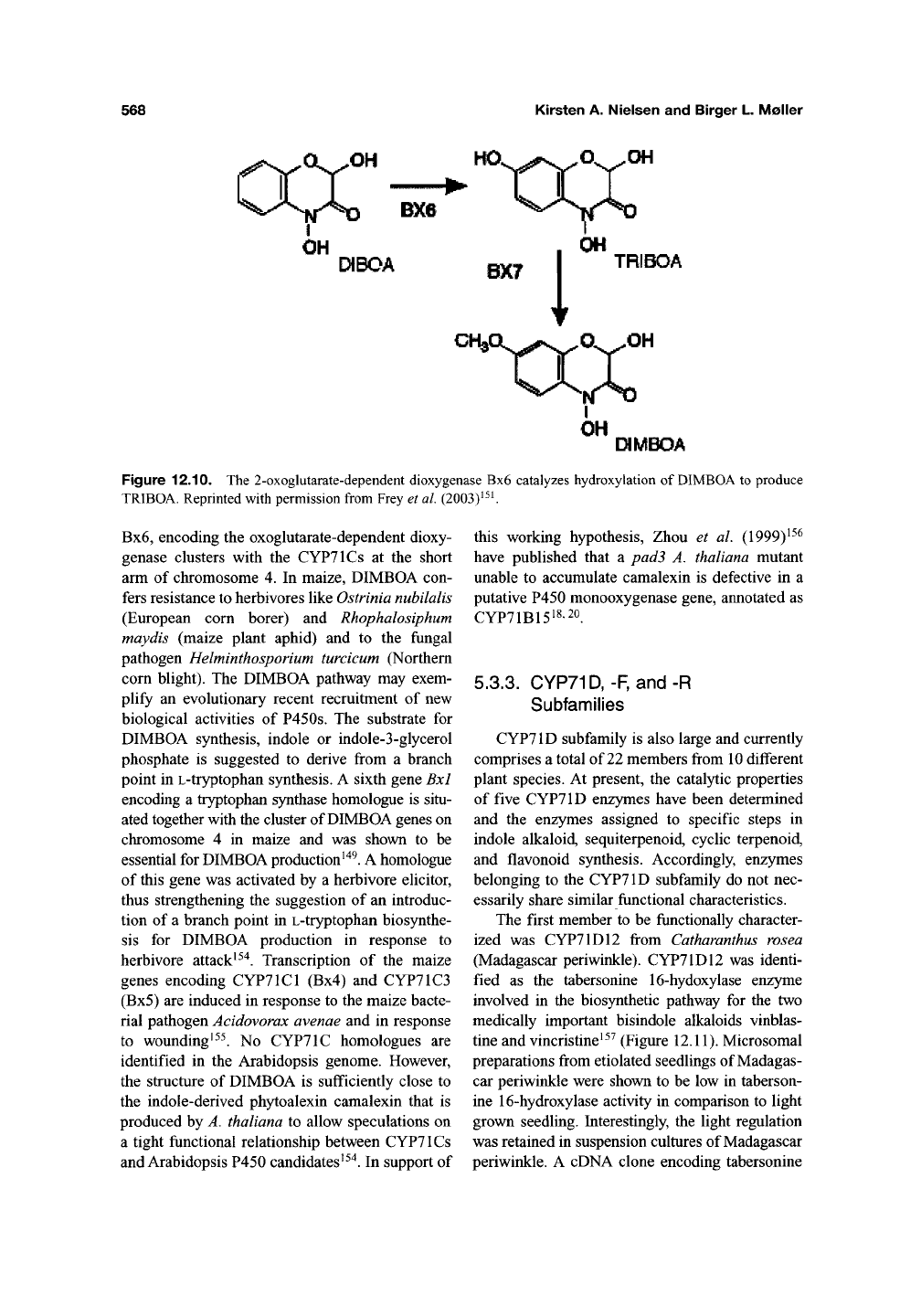
568
Kirsten A. Nielsen and Birger L. Moller
OCT "
O. ^OH
XXY
OH
DIBCA
&J\§
I
OH
TRIBOA
I
OH
DIMBOA
Figure 12.10. The 2-oxoglutarate-dependent dioxygenase Bx6 catalyzes hydroxylation of
DIMBOA
to produce
TRIBOA. Reprinted with permission from Frey et
al.
(2003)^^^
Bx6,
encoding the oxoglutarate-dependent dioxy-
genase clusters with the CYPTlCs at the short
arm of chromosome 4. In maize, DIMBOA con-
fers resistance to herbivores like Ostrinia nubilalis
(European com borer) and Rhophalosiphum
maydis (maize plant aphid) and to the fungal
pathogen Helminthosporium turcicum (Northern
com blight). The DIMBOA pathway may exem-
plify an evolutionary recent recruitment of new
biological activities of P450s. The substrate for
DIMBOA synthesis, indole or indole-3-glycerol
phosphate is suggested to derive from a branch
point in L-tryptophan synthesis. A sixth gene Bxl
encoding a tryptophan synthase homologue is situ-
ated together with the cluster of DIMBOA genes on
chromosome 4 in maize and was shown to be
essential for DIMBOA production''^^. A homologue
of this gene was activated by a herbivore elicitor,
thus strengthening the suggestion of an introduc-
tion of a branch point in L-tryptophan biosynthe-
sis for DIMBOA production in response to
herbivore attack^^^. Transcription of the maize
genes encoding CYP71C1 (Bx4) and CYP71C3
(Bx5) are induced in response to the maize bacte-
rial pathogen Acidovorax avenae and in response
to wounding^^^. No CYP71C homologues are
identified in the Arabidopsis genome. However,
the stmcture of DIMBOA is sufficiently close to
the indole-derived phytoalexin camalexin that is
produced by A. thaliana to allow speculations on
a tight functional relationship between CYPTlCs
and Arabidopsis P450 candidates^^'*. In support of
this working hypothesis, Zhou et al. (1999)^^^
have published that a padS A. thaliana mutant
unable to accumulate camalexin is defective in a
putative P450 monooxygenase gene, atmotated as
CYP71B15'8'2o^
5.3.3. CYP71D,-F, and-R
Subfamilies
CYP71D subfamily is also large and currently
comprises a total of 22 members from 10 different
plant species. At present, the catalytic properties
of five CYP71D enzymes have been determined
and the enzymes assigned to specific steps in
indole alkaloid, sequiterpenoid, cyclic terpenoid,
and flavonoid synthesis. Accordingly, enzymes
belonging to the CYP71D subfamily do not nec-
essarily share similar functional characteristics.
The first member to be functionally character-
ized was CYP71D12 from Catharanthus rosea
(Madagascar periwinkle). CYP71D12 was identi-
fied as the tabersonine 16-hydoxylase enz5niie
involved in the biosynthetic pathway for the two
medically important bisindole alkaloids vinblas-
tine and vincristine^^'^ (Figure 12.11). Microsomal
preparations from etiolated seedlings of Madagas-
car periwinkle were shown to be low in taberson-
ine 16-hydroxylase activity in comparison to light
grown seedling. Interestingly, the light regulation
was retained in suspension cultures of Madagascar
periwinkle. A cDNA clone encoding tabersonine
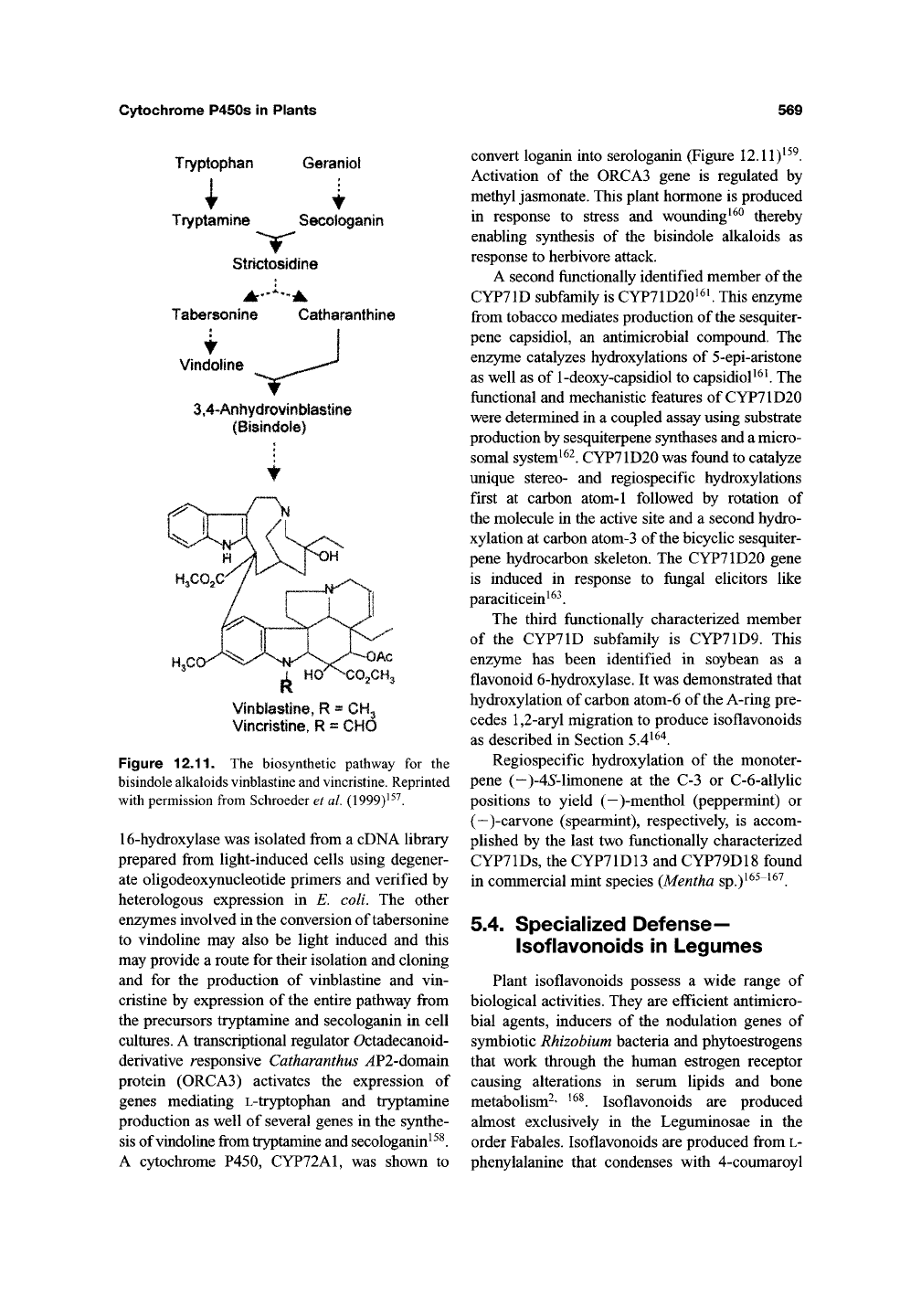
Cytochrome P450s in Plants
569
Tryptophan
Garaoiol
i
t
Tryptamine Secolc^anin
Strictosidine
Tabersonine Catharanthina
t
Vindoline
3,4~Anhydrovinbfa8tine
(Bisindole)
Vioblastlria, R = CHg
Vincristine, R = CHO
Figure
12.11.
The biosynthetic pathway for the
bisindole alkaloids vinblastine and
vincristine.
Reprinted
with permission from Schroeder et
al.
(1999)^^^.
16-hydroxylase was isolated from a cDNA library
prepared from light-induced cells using degener-
ate oligodeoxynucleotide primers and verified by
heterologous expression in E. coli. The other
enzymes involved in the conversion of tabersonine
to vindoline may also be light induced and this
may provide a route for their isolation and cloning
and for the production of vinblastine and vin-
cristine by expression of the entire pathway from
the precursors tryptamine and secologanin in cell
cultures. A transcriptional regulator Octadecanoid-
derivative responsive Catharanthus ^P2-domain
protein (0RCA3) activates the expression of
genes mediating L-tr5^tophan and tryptamine
production as well of several genes in the synthe-
sis of vindoline from tryptamine and secologanin^^^.
A cytochrome P450, CYP72A1, was shown to
convert loganin into serologanin (Figure 12.11)^^^.
Activation of the 0RCA3 gene is regulated by
methyl jasmonate. This plant hormone is produced
in response to stress and wounding^^^ thereby
enabling synthesis of the bisindole alkaloids as
response to herbivore attack.
A second functionally identified member of the
CYP71D subfamily is CYP71D20i^^ This enzyme
from tobacco mediates production of the sesquiter-
pene capsidiol, an antimicrobial compound. The
enzyme catalyzes hydroxylations of 5-epi-aristone
as well as of
1-deoxy-capsidiol
to capsidiol^^^ The
functional and mechanistic features of CYP71D20
were determined in a coupled assay using substrate
production by sesquiterpene synthases and a micro-
somal system
^^^.
CYP71D20 was found to catalyze
unique stereo- and regiospecific hydroxylations
first at carbon atom-1 followed by rotation of
the molecule in the active site and a second hydro-
xylation at carbon atom-3 of the bicyclic sesquiter-
pene hydrocarbon skeleton. The CYP71D20 gene
is induced in response to fungal elicitors like
paraciticein^^^.
The third functionally characterized member
of the CYP71D subfamily is CYP71D9. This
enzyme has been identified in soybean as a
flavonoid 6-hydroxylase. It was demonstrated that
hydroxylation of carbon atom-6 of the A-ring pre-
cedes
1,2-aryl
migration to produce isoflavonoids
as described in Section 5.4^^"^.
Regiospecific hydroxylation of the monoter-
pene (—)-4*S'-limonene at the C-3 or C-6-allylic
positions to yield (—)-menthol (peppermint) or
(—)-carvone (spearmint), respectively, is accom-
plished by the last two functionally characterized
CYP71DS, the CYP71D13 and CYP79D18 found
in commercial mint species {Mentha sp.)^^^"^^^.
5.4. Specialized Defense—
Isoflavonoids in Legumes
Plant isoflavonoids possess a wide range of
biological activities. They are efficient antimicro-
bial agents, inducers of the nodulation genes of
symbiotic Rhizobium bacteria and phytoestrogens
that work through the human estrogen receptor
causing alterations in serum lipids and bone
metabolism^' ^^^. Isoflavonoids are produced
almost exclusively in the Leguminosae in the
order Fabales. Isoflavonoids are produced from
L-
phenylalanine that condenses with 4-coumaroyl
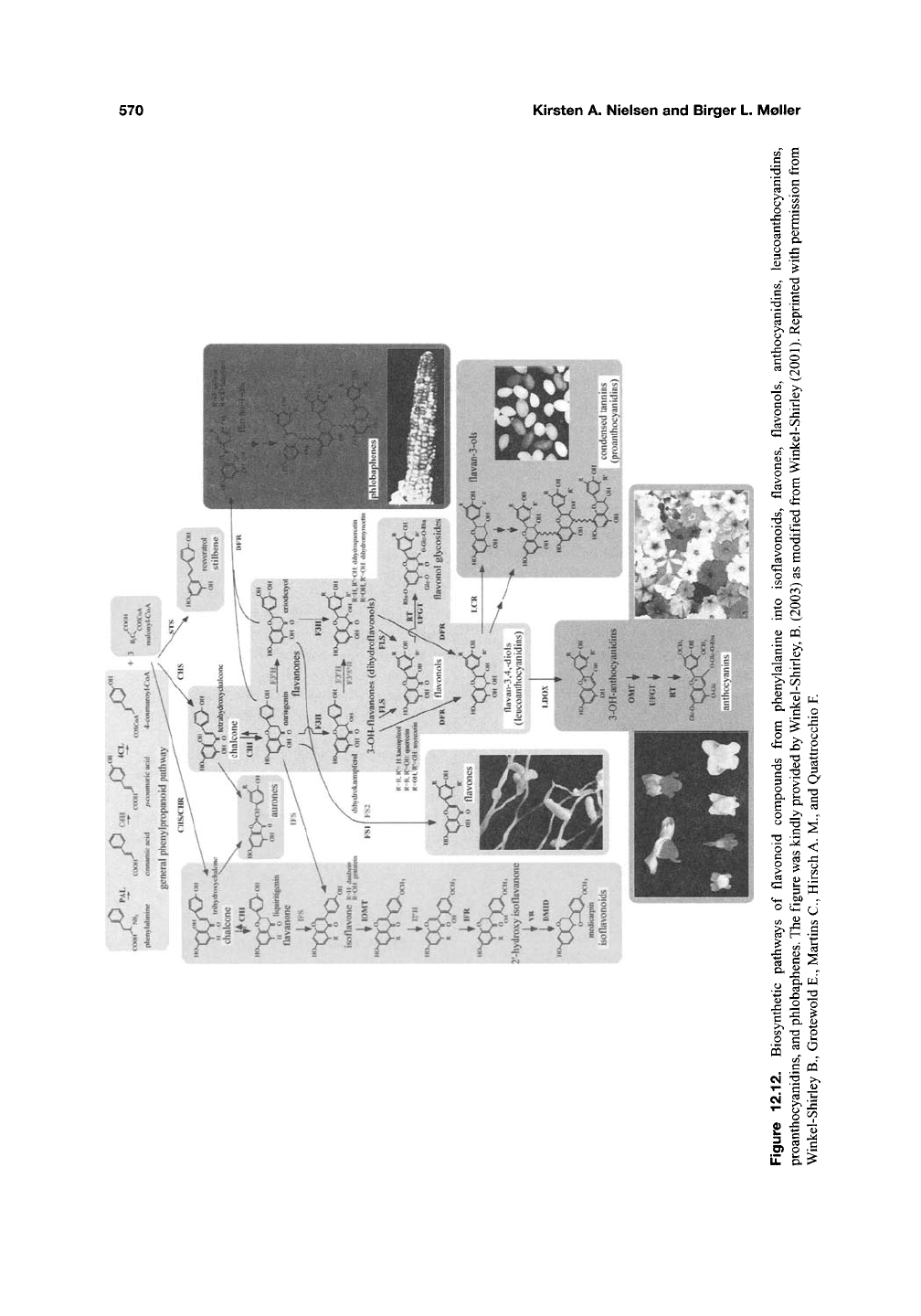
570
Kirsten A. Nielsen and Birger L. Moller
^ tfa
^ ^
>.
c^
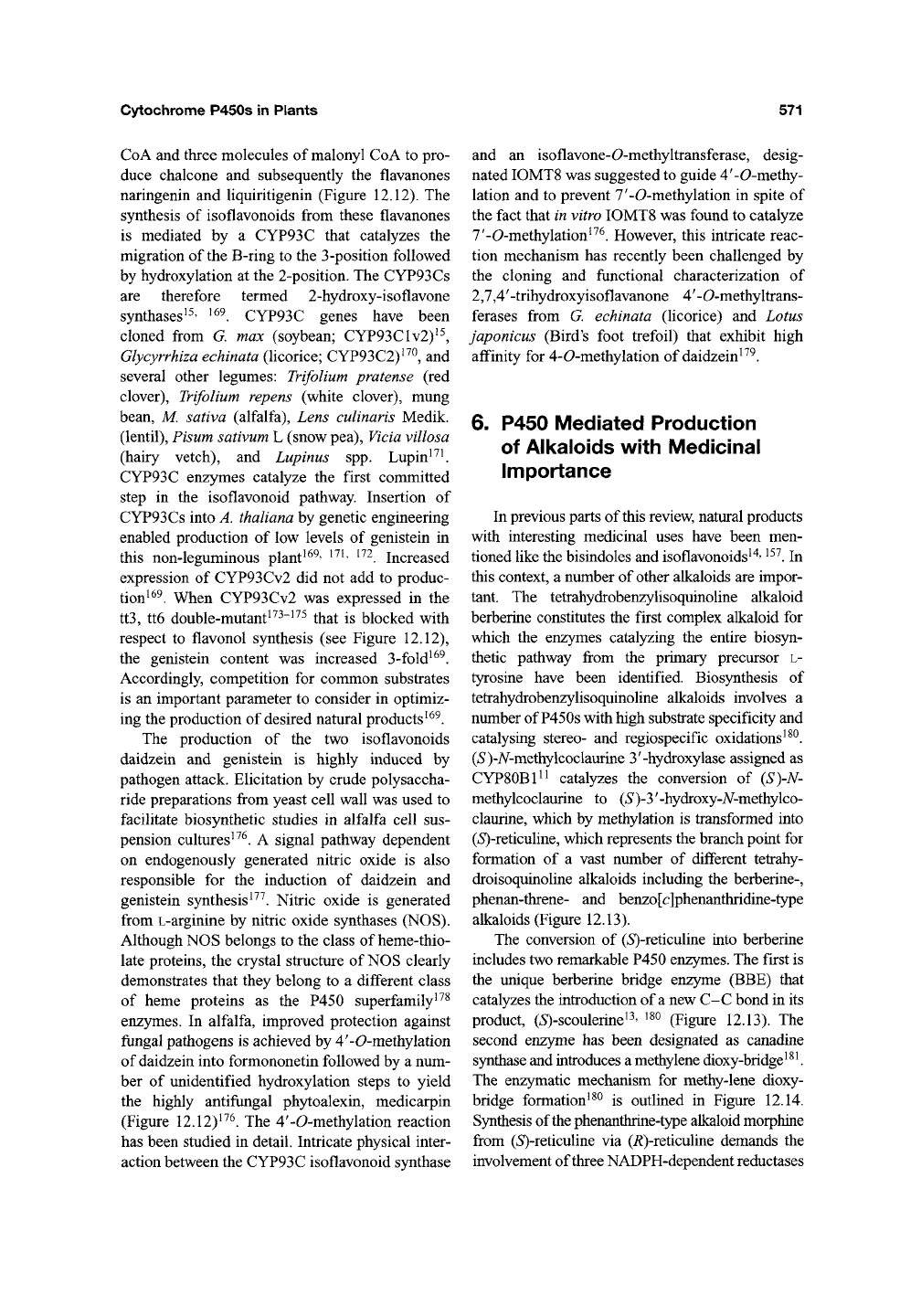
Cytochrome P450s in Plants
571
Co A and three molecules of malonyl CoA to pro-
duce chalcone and subsequently the flavanones
naringenin and liquiritigenin (Figure 12.12). The
synthesis of isoflavonoids from these flavanones
is mediated by a CYP93C that catalyzes the
migration of the B-ring to the 3-position followed
by hydroxylation at the 2-position. The CYP93Cs
are therefore termed 2-hydroxy-isoflavone
synthases^^' ^^^. CYP93C genes have been
cloned from G. max (soybean; CYP93Clv2)^^
Glycyrrhiza echinata (licorice; CYP93C2)^^^, and
several other legumes: Trifolium pratense (red
clover), Trifolium repens (white clover), mung
bean, M. sativa (alfalfa), Lens culinaris Medik.
(lentil),
Pisum sativum L (snow pea),
Vicia
villosa
(hairy vetch), and Lupinus spp. Lupin^-^^
CYP93C enzymes catalyze the first committed
step in the isoflavonoid pathway. Insertion of
CYP93Cs into A. thaliana by genetic engineering
enabled production of low levels of genistein in
this non-leguminous plant^^^' ^^^' ^^^. Increased
expression of CYP93Cv2 did not add to produc-
tion^^^. When CYP93Cv2 was expressed in the
tt3,
tt6 double-mutant^^^-i^^ that is blocked with
respect to flavonol synthesis (see Figure 12.12),
the genistein content was increased 3-fold^^^.
Accordingly, competition for common substrates
is an important parameter to consider in optimiz-
ing the production of desired natural products ^^^.
The production of the two isoflavonoids
daidzein and genistein is highly induced by
pathogen attack. Elicitation by crude polysaccha-
ride preparations from yeast cell wall was used to
facilitate biosynthetic studies in alfalfa cell sus-
pension cultures ^^^. A signal pathway dependent
on endogenously generated nitric oxide is also
responsible for the induction of daidzein and
genistein synthesis ^^^. Nitric oxide is generated
from L-arginine by nitric oxide synthases (NOS).
Although NOS belongs to the class of heme-thio-
late proteins, the crystal structure of NOS clearly
demonstrates that they belong to a different class
of heme proteins as the P450 superfamily^^^
enzymes. In alfalfa, improved protection against
fungal pathogens is achieved by 4'-0-methylation
of daidzein into formononetin followed by a num-
ber of unidentified hydroxylation steps to yield
the highly antifungal phytoalexin, medicarpin
(Figure 12.12)^^^. The 4'-0-methylation reaction
has been studied in detail. Intricate physical inter-
action between the CYP93C isoflavonoid synthase
and an isoflavone-O-methyltransferase, desig-
nated I0MT8 was suggested to guide 4'-0-methy-
lation and to prevent 7'-0-methylation in spite of
the fact that in vitro IOMT8 was found to catalyze
7'-0-methylation^^^. However, this intricate reac-
tion mechanism has recently been challenged by
the cloning and functional characterization of
2,7,4'-trihydroxyisoflavanone 4'-O-methyltrans-
ferases from G. echinata (licorice) and Lotus
Japonicus (Bird's foot trefoil) that exhibit high
affinity for 4-0-methylation of daidzein^'^^.
6. P450 Mediated Production
of Alkaloids with Medicinal
Importance
In previous parts of this review, natural products
with interestmg medicinal uses have been men-
tioned like the bisindoles and isoflavonoids^"^'
^^'^.
In
this context, a number of other alkaloids are impor-
tant. The tetrahydrobenzylisoquinoline alkaloid
berberine constitutes the first complex alkaloid for
which the enzymes catalyzing the entire biosyn-
thetic pathway from the primary precursor L-
tyrosine have been identified. Biosynthesis of
tetrahydrobenzylisoquinoline alkaloids involves a
number of P450s with high substrate specificity and
catalysing stereo- and regiospecific oxidations^^^.
(»S')-Ar-methylcoclaurine 3'-hydroxylase assigned as
CYPSOBl^i catalyzes the conversion of
{S)-N-
methylcoclaurine to (/S')-3'-hydroxy-A/-methylco-
claurine, which by methylation is transformed into
(*S)-reticuline, which represents the branch point for
formation of a vast number of different tetrahy-
droisoquinoline alkaloids including the berberine-,
phenan-threne- and benzo[c]phenanthridine-type
alkaloids (Figure 12.13).
The conversion of (*S)-reticuline into berberine
includes two remarkable P450 enzymes. The first is
the unique berberine bridge
QnzymQ
(BBE) that
catalyzes the introduction of a new C-C bond in its
product, (*S)-scoulerinei3' ^^^ (Figure 12.13). The
second enzyme has been designated as canadine
synthase and introduces a methylene dioxy-bridge^^^
The enzymatic mechanism for methy-lene dioxy-
bridge formation^^^ is outlined in Figure 12.14.
Synthesis of the phenanthrine-type alkaloid morphine
from (*S)-reticuline via (i?)-reticuline demands the
involvement of three NADPH-dependent reductases
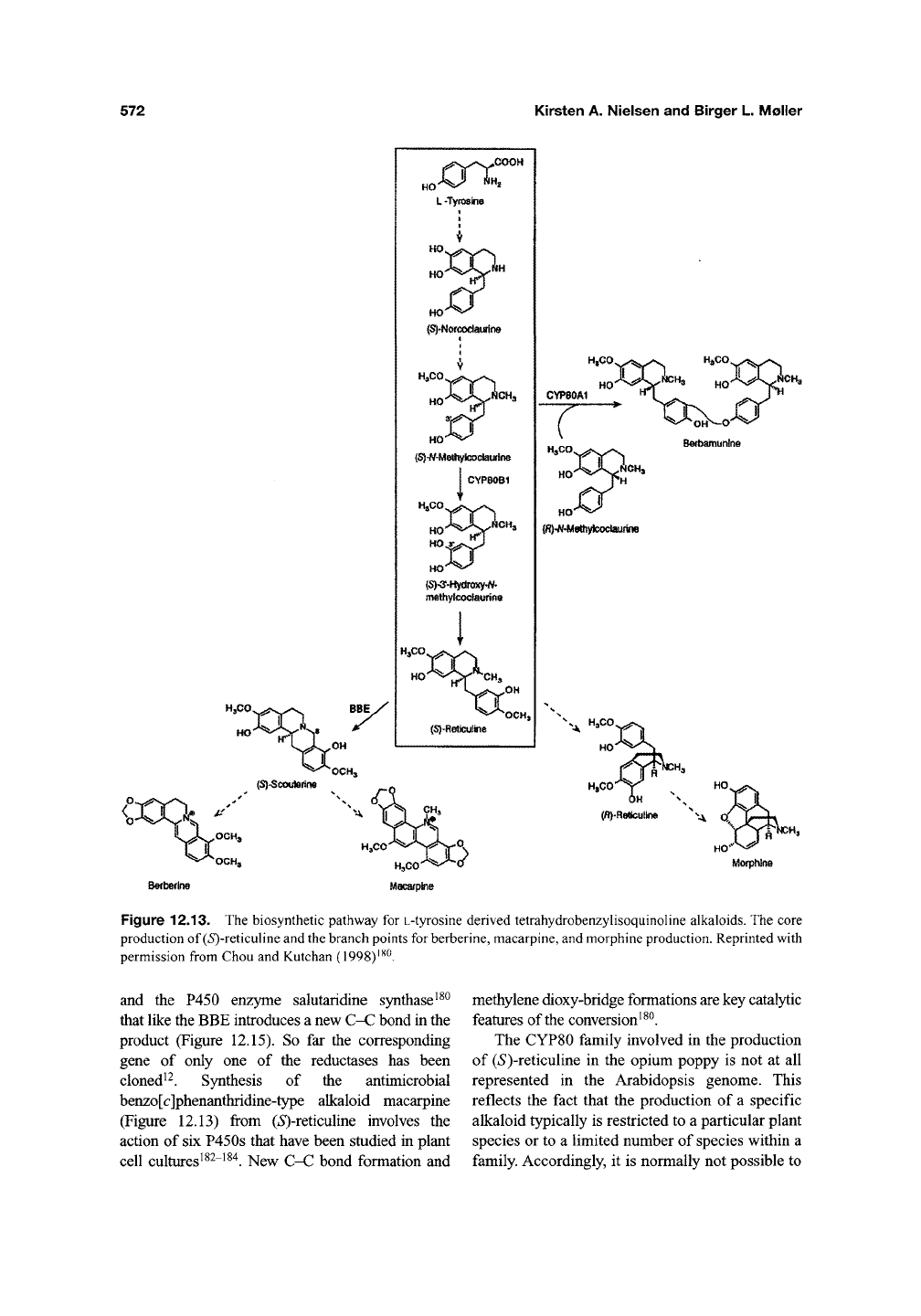
572
Kirsten A. Nielsen and Birger L. Moller
XJi m
CYP8081
HO
mathyr«ocla«ri«e
I
''^'"
^^;*''^(
OCM,
{A)«/tf-Me(hylcoctaurw!8
^*.
H^CO
OCHs
OCH5
(»)«R6liculkw
Figure 12.13. The biosynthetic pathway for
L-tyrosine
derived tetrahydrobenzyUsoquinohne alkaloids. The core
production of (iS)-reticuline and
the
branch points for
berberine,
macarpine, and morphine production. Reprinted with
permission from Chou and Kutchan (1998)'^^.
and the P450 enzyme salutaridine synthase ^^^
that like the BBE introduces a new C-C bond in the
product (Figure 12.15). So far the corresponding
gene of only one of the reductases has been
cloned^ ^. Synthesis of the antimicrobial
benzo[c]phenanthridine-type alkaloid macarpine
(Figure 12.13) from
(*S)-reticuline
involves the
action of six P450s that have been studied in plant
cell cultures^^^~^^'^. New C-C bond formation and
methylene dioxy-bridge formations are key catalytic
features of the conversion^ ^^.
The CYP80 family involved in the production
of ((S')-reticuline in the opium poppy is not at all
represented in the Arabidopsis genome. This
reflects the fact that the production of a specific
alkaloid typically is restricted to a particular plant
species or to a limited number of species within a
family. Accordingly, it is normally not possible to

Cytochrome P450s in Plants
573
study such pathways in genetically well-character-
ized model plants. This greatly complicates eluci-
dation of the biosynthetic pathways involved in
alkaloid formation. Furthermore, alkaloids may
accumulate very slowly over a period of months to
years and in a highly tissue-specific manner. The
establishment of cell cultures have helped to over-
come some of these experimental difficulties ^^^.
Availability of native alkaloid producing plants as
sources for isolation of important medicinal drugs
remain of high importance because controlled
production in, for example, transgenic A. thaliana
is dependent on the availability of the genes
Ring
A Of D
| YV*^"*^^^^^' Heme-iron of
of protobdrberlne
alkaloid
I
^OH
cytochrome
P-450
DOC
'^OHj "•'OrfSS'
l>
Figure 12.14. A proposed mechanism of methylene
dioxy-bridge formation. Reprinted
with
permission from
Chou and Kutchan (1998)^^0.
encoding the entire pathway and hampered by
technical problems in the co-expression of a
multitude of heterologous
genes.
^^^
7. Future Prospects: Crosstalk
and Metabolic Engineering
The multigene family of plant P450s repre-
sents a very rich source for metabolic engineering.
The A-type P450s involved in the synthesis of low
molecular mass natural products is a key target
because many of these compounds are of high
value either as fine chemicals or as plant con-
stituents that provide desired agronomical traits
such as insect or fungal resistance. In all cases, the
P450 enzymes catalyzing the first committed step
in the different pathways leading to the production
of natural products appear to exert a very high
degree of substrate specificity. The successful
transfer of the entire pathway for dhurrin forma-
tion from sorghum to A.
thaliana^^^
demonstrates
that metabolon formation may be achieved also
after heterologous expression of a biosynthetic
pathway in a plant species that would not in nature
produce the same type of natural products.
Insertion of an incomplete pathway was shown to
favor crosstalk with other metabolic pathways
and the formation of side products ^^^. When
separately introduced into A. thaliana, sorghum
CYP79A1 was able to establish highly efficient
fP^"^
Salutaridlne ^^
synthase
^ ^Q.
NADPH,
O2
Demethytation
(P-480)
H3CO.
Demethylation
(P-450)
Neopinone
Figure 12.15. Biosynthesis of morphine
from
(i?)-reticuline. Reprinted with permission
from
Chou and Kutchan
(1998)180.
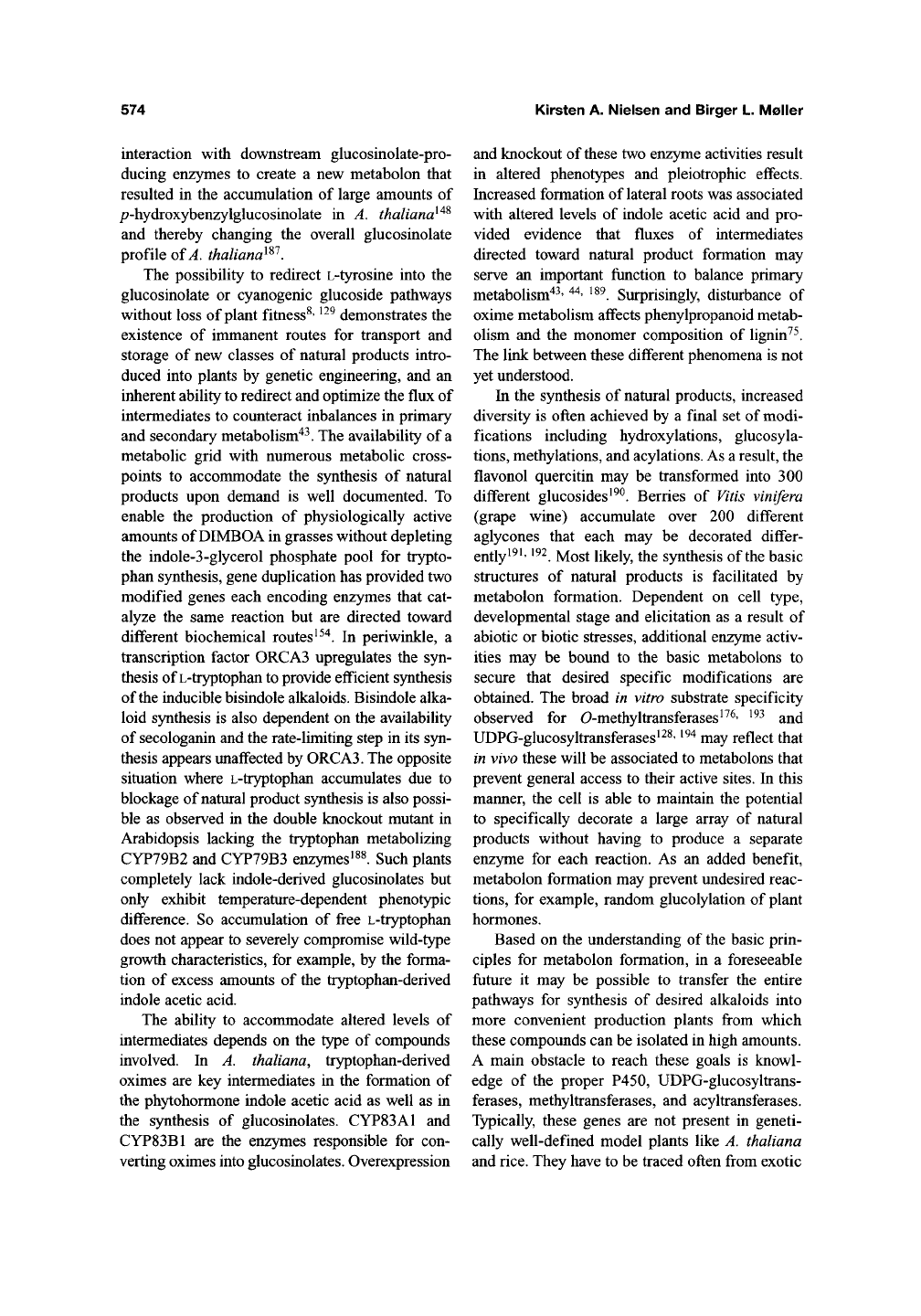
574 Kirsten A. Nielsen and Birger L. Moller
interaction with downstream glucosinolate-pro-
ducing enzymes to create a new metabolon that
resulted in the accumulation of large amounts of
/7-hydroxybenzylglucosinolate in A. thaliana^^^
and thereby changing the overall glucosinolate
profile of ^.
thaliana^^^.
The possibility to redirect L-tyrosine into the
glucosinolate or cyanogenic glucoside pathways
without loss of plant fitness^'
^^^
demonstrates the
existence of immanent routes for transport and
storage of new classes of natural products intro-
duced into plants by genetic engineering, and an
inherent ability to redirect and optimize the flux of
intermediates to counteract inbalances in primary
and secondary metabolism"*^. The availability of a
metabolic grid with numerous metabolic cross-
points to accommodate the synthesis of natural
products upon demand is well documented. To
enable the production of physiologically active
amounts of DIMBOA in grasses without depleting
the indole-3-glycerol phosphate pool for trypto-
phan synthesis, gene duplication has provided two
modified genes each encoding enzymes that cat-
alyze the same reaction but are directed toward
different biochemical routes^^'*. In periwinkle, a
transcription factor 0RCA3 upregulates the syn-
thesis of L-tryptophan to provide efficient synthesis
of the inducible bisindole alkaloids. Bisindole alka-
loid synthesis is also dependent on the availability
of secologanin and the rate-limiting step in its syn-
thesis appears unaffected by 0RCA3. The opposite
situation where L-tryptophan accumulates due to
blockage of natural product synthesis is also possi-
ble as observed in the double knockout mutant in
Arabidopsis lacking the tryptophan metabolizing
CYP79B2 and CYP79B3 enzymes'^l Such plants
completely lack indole-derived glucosinolates but
only exhibit temperature-dependent phenotypic
difference. So accumulation of free L-tryptophan
does not appear to severely compromise wild-type
growth characteristics, for example, by the forma-
tion of excess amounts of the tryptophan-derived
indole acetic acid.
The ability to accommodate altered levels of
intermediates depends on the type of compounds
involved. In A. thaliana, tryptophan-derived
oximes are key intermediates in the formation of
the phytohormone indole acetic acid as well as in
the synthesis of glucosinolates. CYP83A1 and
CYP83B1 are the enzymes responsible for con-
verting oximes into glucosinolates. Overexpression
and knockout of these two enzyme activities result
in altered phenotypes and pleiotrophic effects.
Increased formation of lateral roots was associated
with altered levels of indole acetic acid and pro-
vided evidence that fluxes of intermediates
directed toward natural product formation may
serve an important frinction to balance primary
metabolism"*^' ^'*' ^^^. Surprisingly, disturbance of
oxime metabolism affects phenylpropanoid metab-
olism and the monomer composition of lignin^^.
The link between these different phenomena is not
yet understood.
In the synthesis of natural products, increased
diversity is often achieved by a final set of modi-
fications including hydroxylations, glucosyla-
tions,
methylations, and acylations. As a result, the
flavonol quercitin may be transformed into 300
different glucosides^^^. Berries of Vitis vinifera
(grape wine) accumulate over 200 different
aglycones that each may be decorated differ-
ently^^^'
^^^.
Most likely, the synthesis of the basic
structures of natural products is facilitated by
metabolon formation. Dependent on cell type,
developmental stage and elicitation as a result of
abiotic or biotic stresses, additional enzyme activ-
ities may be bound to the basic metabolons to
secure that desired specific modifications are
obtained. The broad in vitro substrate specificity
observed for 0-methyltransferases^'^^' *^^ and
UDPG-glucosyltransferases*^^'
^^"^
may reflect that
in vivo these will be associated to metabolons that
prevent general access to their active sites. In this
manner, the cell is able to maintain the potential
to specifically decorate a large array of natural
products without having to produce a separate
enzyme for each reaction. As an added benefit,
metabolon formation may prevent undesired reac-
tions,
for example, random glucolylation of plant
hormones.
Based on the understanding of the basic prin-
ciples for metabolon formation, in a foreseeable
future it may be possible to transfer the entire
pathways for synthesis of desired alkaloids into
more convenient production plants from which
these compounds can be isolated in high amounts.
A main obstacle to reach these goals is knowl-
edge of the proper P450, UDPG-glucosyltrans-
ferases, methyltransferases, and acyltransferases.
Typically, these genes are not present in geneti-
cally well-defined model plants like A. thaliana
and rice. They have to be traced often from exotic
